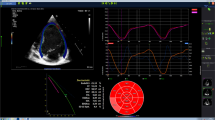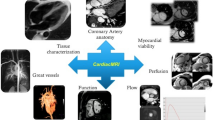Abstract
Congenital heart disease (CHD) affects around 1 in every 100 babies. Cardiovascular imaging has enabled significant advances in the management of CHD; however, it has multiple challenges in this population. Acquisition of imaging data is particularly challenging in the paediatric population, as it can be time-consuming and requires patient cooperation. Post-processing and analysis of images from CHD are often difficult and performed manually; hence, it is time-consuming and requires expert users. In addition, diagnosis and outcome predictions are based on complex models. Recently, a wide range of applications for artificial intelligence (AI) have been developed to tackle these challenges, demonstrating great potential. In this chapter, we review the current literature in applying AI in imaging for patients with CHD and discuss current barriers to translation of these technologies.
Access this chapter
Tax calculation will be finalised at checkout
Purchases are for personal use only
Similar content being viewed by others
References
Wang G, Ye JC, Mueller K, Fessler JA. Image reconstruction is a new frontier of machine learning. IEEE Trans Med Imaging. 2018;37:1289–96.
Ben Yedder H, Cardoen B, Hamarneh G. Deep learning for biomedical image reconstruction: a survey. Artif Intell Rev. 2020; https://doi.org/10.1007/s10462-020-09861-2.
Zhang H-M, Dong B. A review on deep learning in medical image reconstruction. J Oper Res Soc China. 2020;8:311–40. https://doi.org/10.1007/s40305-019-00287-4.
Huijben IAM, Veeling BS, Janse K, Mischi M, Sloun RJG, v. Learning sub-sampling and signal recovery with applications in ultrasound imaging. IEEE Trans Med Imaging. 2020;39:3955–66. https://doi.org/10.1109/TMI.2020.3008501.
van Sloun RJG, Cohen R, Eldar YC. Deep learning in ultrasound imaging. Proc IEEE. 2020;108:11–29. https://doi.org/10.1109/JPROC.2019.2932116.
Diller G-P, et al. Denoising and artefact removal for transthoracic echocardiographic imaging in congenital heart disease: utility of diagnosis specific deep learning algorithms. Int J Cardiovasc Imaging. 2019;35:2189–96. https://doi.org/10.1007/s10554-019-01671-0.
Krupickova S, et al. Echocardiographic arterial measurements in complex congenital diseases before bidirectional Glenn: comparison with cardiovascular magnetic resonance imaging. Eur Heart J Cardiovasc Imaging. 2016;18:332–41. https://doi.org/10.1093/ehjci/jew069.
Moledina S, et al. Prognostic significance of cardiac magnetic resonance imaging in children with pulmonary hypertension. Circulation Cardiovasc Imaging. 2013;6:407–14. https://doi.org/10.1161/CIRCIMAGING.112.000082.
Montalt-Tordera J, Muthurangu V, Hauptmann A, Steeden JA. Machine learning in Magnetic Resonance Imaging: Image reconstruction. Physica Medica. 2021;83:79–87. https://doi.org/10.1016/j.ejmp.2021.02.020.
Knoll F, et al. Deep-learning methods for parallel magnetic resonance imaging reconstruction: a survey of the current approaches, trends, and issues. IEEE Signal Process Mag. 2020;37:128–40. https://doi.org/10.1109/MSP.2019.2950640.
Liang D, Cheng J, Ke Z, Ying L. Deep magnetic resonance image reconstruction: inverse problems meet neural networks. IEEE Signal Process Mag. 2020;37:141–51. https://doi.org/10.1109/MSP.2019.2950557.
Hauptmann A, Arridge S, Lucka F, Muthurangu V, Steeden JA. Real-time cardiovascular MR with spatio-temporal artifact suppression using deep learning–proof of concept in congenital heart disease. Magn Reson Med. 2019;81:1143–56. https://doi.org/10.1002/mrm.27480.
Feng L, et al. Golden-angle radial sparse parallel MRI: combination of compressed sensing, parallel imaging, and golden-angle radial sampling for fast and flexible dynamic volumetric MRI. MRM. 2014;72:707–17. https://doi.org/10.1002/mrm.24980.
Steeden JA, et al. Rapid whole-heart CMR with single volume super-resolution. J Cardiovasc Magn Reson. 2020;22:56. https://doi.org/10.1186/s12968-020-00651-x.
Montalt-Tordera J, Quail M, Steeden JA, Muthurangu V. Reducing contrast agent dose in cardiovascular MR angiography with deep learning. JMRI. 2021;54:795.
Petitjean C, Dacher J-N. A review of segmentation methods in short axis cardiac MR images. Med Image Anal. 2011;15:169–84. https://doi.org/10.1016/j.media.2010.12.004.
Tavakoli V, Amini AA. A survey of shaped-based registration and segmentation techniques for cardiac images. Comput Vis Image Underst. 2013;117:966–89. https://doi.org/10.1016/j.cviu.2012.11.017.
Heimann T, Meinzer H-P. Statistical shape models for 3D medical image segmentation: a review. Med Image Anal. 2009;13:543–63. https://doi.org/10.1016/j.media.2009.05.004.
Suinesiaputra A, et al. A collaborative resource to build consensus for automated left ventricular segmentation of cardiac MR images. Med Image Anal. 2014;18:50–62. https://doi.org/10.1016/j.media.2013.09.001.
Zuluaga MA, Bhatia K, Kainz B, Moghari MH, Pace DF. Reconstruction, segmentation, and analysis of medical images: first international workshops, RAMBO 2016 and HVSMR 2016, held in conjunction with MICCAI 2016, Athens, Greece, October 17, 2016, revised selected papers. Vol. 10129 (Springer, 2017).
Yu L, Yang X, Qin J, Heng PA. 3D FractalNet: Dense Volumetric Segmentation for Cardiovascular MRI Volumes. In: Zuluaga M, Bhatia K, Kainz B, Moghari M, Pace D. (eds) Reconstruction, Segmentation, and Analysis of Medical Images. RAMBO 2016, HVSMR 2016. Lecture Notes in Computer Science, vol 10129. Springer, Cham. 2017. https://doi.org/10.1007/978-3-319-52280-7_10.
Wolterink JM, Leiner T, Viergever MA, Išgum I. Dilated Convolutional Neural Networks for Cardiovascular MR Segmentation in Congenital Heart Disease. In: Zuluaga M., Bhatia K., Kainz B., Moghari M., Pace D. (eds) Reconstruction, Segmentation, and Analysis of Medical Images. RAMBO 2016, HVSMR 2016. Lecture Notes in Computer Science, vol 10129. Springer, Cham. 2017. https://doi.org/10.1007/978-3-319-52280-7_9.
Yu L. et al. Automatic 3D Cardiovascular MR Segmentation with Densely-Connected Volumetric ConvNets. In: Descoteaux M, Maier-Hein L, Franz A, Jannin P, Collins D, Duchesne S. (eds) Medical Image Computing and Computer-Assisted Intervention − MICCAI 2017. MICCAI 2017. Lecture Notes in Computer Science, vol 10434. Springer, Cham. 2017. https://doi.org/10.1007/978-3-319-66185-8_33.
Poudel R.P.K., Lamata P., Montana G. Recurrent Fully Convolutional Neural Networks for Multi-slice MRI Cardiac Segmentation. In: Zuluaga M., Bhatia K., Kainz B., Moghari M., Pace D. (eds) Reconstruction, Segmentation, and Analysis of Medical Images. RAMBO 2016, HVSMR 2016. Lecture Notes in Computer Science, vol 10129. Springer, Cham. 2017. https://doi.org/10.1007/978-3-319-52280-7_8.
Rezaei M, Yang H, Meinel C. Recurrent generative adversarial network for learning imbalanced medical image semantic segmentation. Multimed Tools Appl. 2020;79:15329–48. https://doi.org/10.1007/s11042-019-7305-1.
Mukhopadhyay A. Total Variation Random Forest: Fully Automatic MRI Segmentation in Congenital Heart Diseases. In: Zuluaga M., Bhatia K., Kainz B., Moghari M., Pace D. (eds) Reconstruction, Segmentation, and Analysis of Medical Images. RAMBO 2016, HVSMR 2016. Lecture Notes in Computer Science, vol 10129. Springer, Cham. 2017. https://doi.org/10.1007/978-3-319-52280-7_17.
Karimi-Bidhendi S, et al. Fully-automated deep-learning segmentation of pediatric cardiovascular magnetic resonance of patients with complex congenital heart diseases. J Cardiovasc Magn Reson. 2020;22:80. https://doi.org/10.1186/s12968-020-00678-0.
Jani VP, et al. Transfer learning for automated aortic segmentation and assessment of aortic mechanics in tetralogy of fallot: multi-ethnic study of atherosclerosis and the German Competence Network for congenital heart defects. Circulation. 2019;140:–A16044. https://doi.org/10.1161/circ.140.suppl_1.16044.
Diller GP, et al. Prediction of prognosis in patients with tetralogy of Fallot based on deep learning imaging analysis. Heart. 2020;106:1007–14.
Xu X. et al. Whole Heart and Great Vessel Segmentation in Congenital Heart Disease Using Deep Neural Networks and Graph Matching. In: Shen D. et al. (eds) Medical Image Computing and Computer Assisted Intervention – MICCAI 2019. MICCAI 2019. Lecture Notes in Computer Science, vol 11765. Springer, Cham. 2019. https://doi.org/10.1007/978-3-030-32245-8_53.
Xu X. et al. ImageCHD: A 3D Computed Tomography Image Dataset for Classification of Congenital Heart Disease. In: Martel AL. et al. (eds) Medical Image Computing and Computer Assisted Intervention – MICCAI 2020. MICCAI 2020. Lecture Notes in Computer Science, vol 12264. Springer, Cham. 2020. https://doi.org/10.1007/978-3-030-59719-1_8.
Liu T, Tian Y, Zhao S, Huang X. Graph Reasoning and Shape Constraints for Cardiac Segmentation in Congenital Heart Defect. In: Martel A.L. et al. (eds) Medical Image Computing and Computer Assisted Intervention – MICCAI 2020. MICCAI 2020. Lecture Notes in Computer Science, vol 12264. Springer, Cham. 2020. https://doi.org/10.1007/978-3-030-59719-1_59.
Diller G-P, et al. Utility of machine learning algorithms in assessing patients with a systemic right ventricle. Eur Heart J Cardiovasc Imaging. 2019;20:925–31. https://doi.org/10.1093/ehjci/jey211.
Thomford NE, et al. Implementing artificial intelligence and digital health in resource-limited settings? Top 10 lessons we learned in congenital heart defects and cardiology. OMICS J Integr Biol. 2020;24:264–77.
Toba S, et al. Prediction of pulmonary to systemic flow ratio in patients with congenital heart disease using deep learning–based analysis of chest radiographs. JAMA Cardiol. 2020;5:449–57. https://doi.org/10.1001/jamacardio.2019.5620.
Arnaout R, et al. Expert-level prenatal detection of complex congenital heart disease from screening ultrasound using deep learning. medRxiv, 2020.2006.2022.20137786. https://doi.org/10.1101/2020.06.22.20137786.
Qiu X, et al. Prenatal diagnosis and pregnancy outcomes of 1492 fetuses with congenital heart disease: role of multidisciplinary-joint consultation in prenatal diagnosis. Sci Rep. 2020;10:7564. https://doi.org/10.1038/s41598-020-64591-3.
Le TK, et al. Application of machine learning in screening of congenital heart diseases using fetal echocardiography. J Am Coll Cardiol. 2020;75:648.
Samad MD, et al. Predicting deterioration of ventricular function in patients with repaired tetralogy of Fallot using machine learning. Eur Heart J Cardiovasc Imaging. 2018;19:730–8.
Valente AM, Powell AJ. Clinical applications of cardiovascular magnetic resonance in congenital heart disease. Magn Reson Imaging Clin N Am. 2007;15:565–77.
Geva T, Sandweiss BM, Gauvreau K, Lock JE, Powell AJ. Factors associated with impaired clinical status in long-term survivors of tetralogy of Fallot repair evaluated by magnetic resonance imaging. J Am Coll Cardiol. 2004;43:1068–74.
Huang L, et al. Prediction of pulmonary pressure after Glenn shunts by computed tomography–based machine learning models. Eur Radiol. 2020;30:1369–77.
Davies R, Babu-Narayan SV. Deep learning in congenital heart disease imaging: hope but not haste. Heart. 2020;106:960. https://doi.org/10.1136/heartjnl-2019-316496.
Author information
Authors and Affiliations
Corresponding author
Editor information
Editors and Affiliations
Rights and permissions
Copyright information
© 2022 The Author(s), under exclusive license to Springer Nature Switzerland AG
About this chapter
Cite this chapter
Steeden, J.A., Muthurangu, V., Secinaro, A. (2022). Artificial Intelligence-Based Evaluation of Congenital Heart Disease. In: De Cecco, C.N., van Assen, M., Leiner, T. (eds) Artificial Intelligence in Cardiothoracic Imaging. Contemporary Medical Imaging. Humana, Cham. https://doi.org/10.1007/978-3-030-92087-6_36
Download citation
DOI: https://doi.org/10.1007/978-3-030-92087-6_36
Published:
Publisher Name: Humana, Cham
Print ISBN: 978-3-030-92086-9
Online ISBN: 978-3-030-92087-6
eBook Packages: MedicineMedicine (R0)




